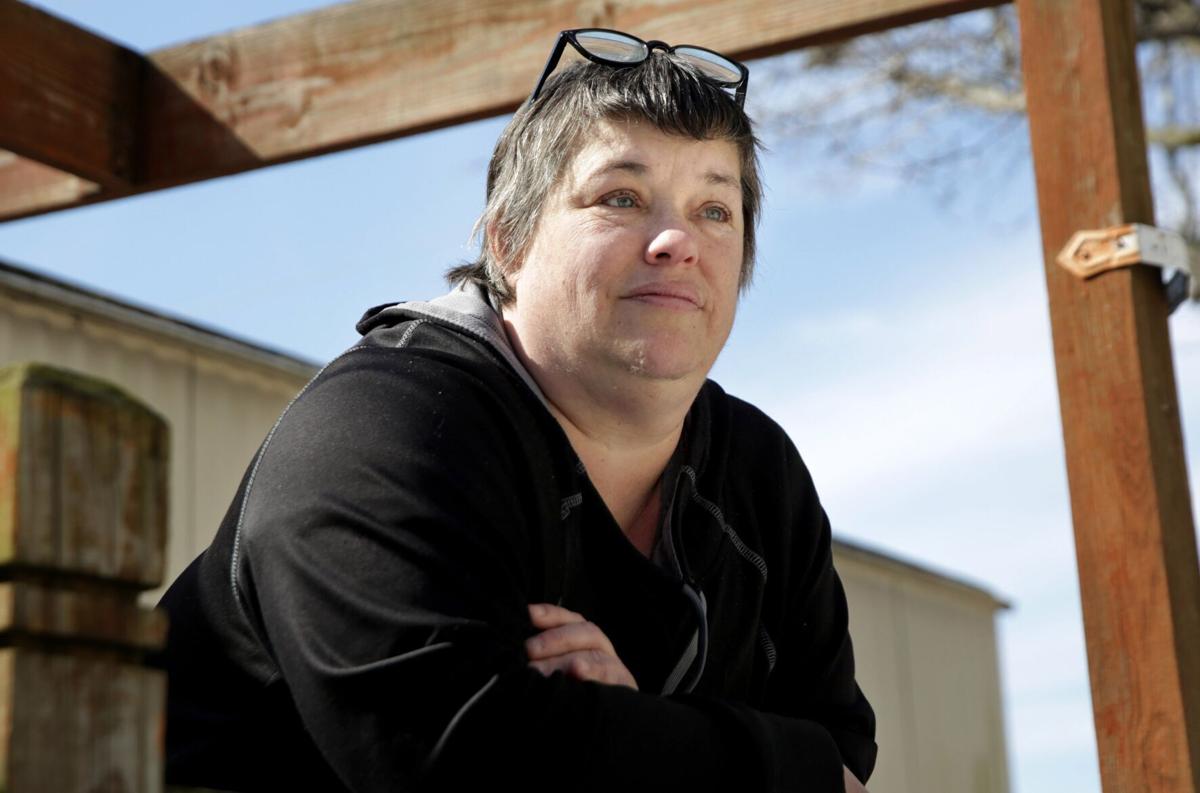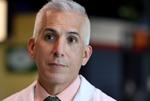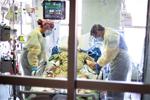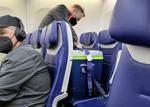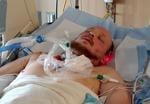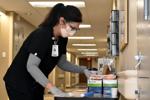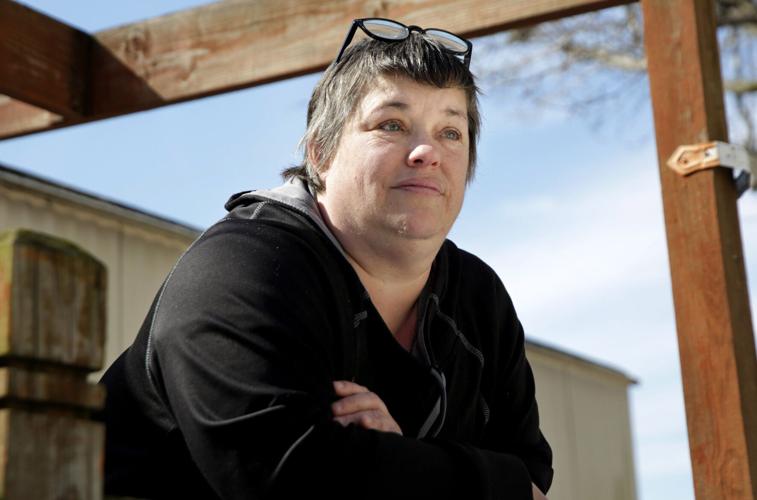ST. LOUIS ŌĆö Cindi Rios Lobo says she is tired. Tired of being told to stay home. Tired of being told not to worry, that COVID-19 is just a cold.
Rios Lobo, 46, of the Fenton area, has Type 2 diabetes and rheumatoid arthritis, which requires her to take medicine that suppresses her immune system. This places her at risk of weakened protection from vaccines and serious outcomes if she gets COVID-19.
But she has five children ŌĆö four of whom live with her ŌĆö and she has no choice but to interact with other people.
ėŻ╠ę╩ėŲĄ County Executive Sam Page on Monday, Feb. 28, 2022, announces the ėŻ╠ę╩ėŲĄ County mask mandate has been lifted.
ŌĆ£I canŌĆÖt stay home and not care for my family,ŌĆØ Rios Lobo said. ŌĆ£We all have to shop. We all have doctorsŌĆÖ appointments.ŌĆØ
She feels increasingly vulnerable as her childrenŌĆÖs schools in the Fox School District in Jefferson County no longer require kids and staff to wear masks. On Monday, the mask mandate ends in ėŻ╠ę╩ėŲĄ County, where she does her shopping.
People are also reading…
ŌĆ£I am just so tired of feeling like my life doesnŌĆÖt matter so someone else can be comfortable not wearing a mask,ŌĆØ she said.
Rios Lobo and millions of vulnerable Americans are worried as the nation heads into the third year of the pandemic with state and local governments and school boards shedding mask requirements and other prevention measures.
ėŻ╠ę╩ėŲĄ CountyŌĆÖs mandate ends at 8 a.m. Monday. The mandate for the city of ėŻ╠ę╩ėŲĄ is set to expire March 6.

Cardboard cutouts of unmasked movie stars line the windows of the Peacock Diner in the Delmar Loop in University City as the end of the ėŻ╠ę╩ėŲĄ County mask mandate approaches on Friday, Feb. 25, 2022. Photo by Robert Cohen, rcohen@post-dispatch.com
Cases are plummeting from record-high levels in January that overwhelmed hospitals and added to death tolls. Officials say they want to take advantage of the increased levels of immunity and give the pandemic-weary public a break from restrictions should cases surge once again.
ŌĆ£I think we should recognize that we are in a much better place, and we are definitely headed in the right direction,ŌĆØ said ėŻ╠ę╩ėŲĄ County Executive Sam Page when he announced the end to the mandate.
The easing of local restrictions comes as the federal government issues new guidance on masks.
On Friday, the that focus less on positive test results and more on hospitalizations. The rate of hospital admissions, share of hospital beds being used by COVID-19 patients, and number of new cases will determine a countyŌĆÖs ŌĆ£community level.ŌĆØ
In counties where the level is low or medium ŌĆö including currently all in the ėŻ╠ę╩ėŲĄ metro area ŌĆö people can stop wearing masks indoors in most cases, the agency said.

A mask lies outside a Chick-fil-A in Des Peres on Friday, Feb. 25, 2022. ėŻ╠ę╩ėŲĄ County is dropping its mask mandate for indoor public places beginning Monday, Feb. 28. The City of ėŻ╠ę╩ėŲĄ' current indoor mask mandate is set to expire March 6. Photo by Joseph Cooke, jcooke@post-dispatch.com
The CDC still advises people, including schoolchildren, to wear masks where the risk of COVID-19 is high. ThatŌĆÖs the situation in about 35% of MissouriŌĆÖs counties, most in the northwest corner of the state. The new recommendations do not change the requirement to wear masks on public transportation and indoors in airports, train stations and bus stations.

Ryan August, general manager of Gezellig Tap House & Bottleshop, clears snow off the ground on Friday, Feb. 25, 2022, near a sign that requires customers to wear masks in the tavern to prevent the spread of COVID-19. ėŻ╠ę╩ėŲĄ County is dropping its mask mandate for indoor public places beginning Monday, Feb. 28. The City of ėŻ╠ę╩ėŲĄ' current indoor mask mandate is set to expire March 6. Photo by Joseph Cooke, jcooke@post-dispatch.com
Kristina Burton, 54, from Nixa, Missouri, just outside Springfield, developed an autoimmune disorder at the age of 39. Still, she considers herself lucky. She is a retired psychologist and financially stable. She is able to keep herself safe by staying home, while others at high risk have to go to work or care for young children.
ŌĆ£ItŌĆÖs difficult to navigate this pandemic as a person who is vulnerable because it feels like we are forgotten or dismissed,ŌĆØ Burton said.
She wishes she could go to her grandchildrenŌĆÖs sports games, or even just do her own grocery shopping and pick out her own fruit.
ŌĆ£I donŌĆÖt expect anyone to wear a mask for the rest of their lives, but when we have ŌĆ”,ŌĆØ Burton said.
ŌĆ£Healthy people should get on with their lives, but they canŌĆÖt forget people like us out there that rely on them to do some simple things to help protect us, like wear a mask.ŌĆØ
Get boosted
About 3% of adults in the U.S. ŌĆö more than 7 million people ŌĆö are considered immunocompromised, meaning their immune system is weak because of disease or medications they take. Vaccines have been shown to not work as well in these groups.
Tens of millions also have conditions such as obesity or heart failure that put them at greater risk from COVID-19. Those who are also elderly are especially susceptible to severe illness and death.
In Missouri, about 14% of COVID-19 deaths since Jan. 1, 2021 (around the time when vaccines first became available) have been among those who are fully vaccinated ŌĆö amounting to more than 1,500 people, . Of those deaths, the average age was 77 and 95% had high-risk conditions.
Vulnerable Missourians are also fearful of hospital stays or long COVID, a condition in which individuals suffer from a range of symptoms long after infections, even mild infections, which vaccines canŌĆÖt always prevent.
Breakthrough infections among the fully vaccinated became more common during the latest wave caused by the hyper-infectious omicron variant, state data shows. Each week in January, between 45% and 47% of cases were among the fully vaccinated.
Throughout February, around 40% of patients in ėŻ╠ę╩ėŲĄ-area hospitals with COVID-19 were fully vaccinated, according to data maintained by the ėŻ╠ę╩ėŲĄ Metropolitan Pandemic Task Force.
Infectious disease experts say those who are vulnerable can take steps to protect themselves. The most important being getting fully vaccinated and boosted against COVID-19.
Boosters were first approved at the end of September for those over the age of 65 and others who are at high-risk. The CDC that everyone age 12 and older get a booster shot after they have completed their primary vaccine series ŌĆö five months after getting two doses of vaccines made by Pfizer-BioNTech and Moderna, or two months after a single dose of the Johnson & Johnson vaccine.
Recent found that vaccine effectiveness against hospitalization with the omicron variant fell to 57% in people who had received their second dose more than six months earlier. A third shot restored that protection to 91% within two months after getting the shot and 78% after four months.
Data in Missouri shows that among 12,776 patients hospitalized with COVID-19 between Oct. 1 and Dec. 1 (the latest data available), nearly 75% were unvaccinated compared to 6% who were boosted. The small number who ended up hospitalized despite being boosted were much older and sicker.
Among the patients who were unvaccinated, fully vaccinated and boosted, the average age of patients was 56, 65 and 71 respectively; the percent with underlying health conditions was 71%, 82% and 85% respectively.
Yet in Missouri, only 40% of those fully vaccinated have gotten booster doses, . Even among residents in MissouriŌĆÖs nursing homes, despite being the most at-risk, 87% are fully vaccinated and just 64% of those are boosted.
, co-director of the infectious diseases division at Washington University School of Medicine, said he suspects thatŌĆÖs because information and efforts surrounding getting people boosted have paled in comparison to getting people vaccinated.
ŌĆ£What you have then is a situation where you have some individuals who are very well-informed and some individuals who donŌĆÖt have information and donŌĆÖt realize the importance of boosting or maintaining their immunity,ŌĆØ said Powderly, who also treats patients at Barnes-Jewish Hospital.
The understanding of boostersŌĆÖ importance also evolved during the delta wave in the late summer and the omicron surge.
ŌĆ£We realized that people who are boosted had the most protection and were extraordinarily unlikely to be in our hospitals and to be in our ICUs (intensive care units),ŌĆØ Powderly said.
ŌĆ£Given that older people will remain vulnerable as this virus continues to circulate, itŌĆÖs really important to remind people, and to remind their family members, that the best way to protect them is to maintain their vaccination status.ŌĆØ
Effective treatment
Wearing a high-quality, tight-fitting mask such as an N95 mask can also provide additional protection, even when around others who are not masked, he said.
ŌĆ£ItŌĆÖs not about becoming a hermit. I think itŌĆÖs really important that we recognize that social contact is important for everybody,ŌĆØ Powderly said. ŌĆ£But it is about helping people maintain their own protection by vaccination and then being sensible. If you are in a very crowded situation, you are protecting yourself, whether you are 25 or 75, if you wear a mask.ŌĆØ
In addition, new and antiviral pills shown to work against the omicron variant are becoming increasingly available after being in short supply. , given to high-risk individuals within days of testing positive for COVID-19, greatly reduce the chance of ending up in the hospital.
One infusion, , can even be used to help prevent infection in those whose immune systems are moderately or severely compromised.
ŌĆ£We do have effective treatment if given early enough. So, we are in a very different place than we were a year ago or two years ago,ŌĆØ Powderly said.
, chief quality officer for BJC HealthCare and professor of surgery at Washington University School of Medicine, explained that doctors must refer patients for the therapies.
Supply of the therapies is increasing, but doctors are also referring their patients less frequently, he said, and not just because fewer are getting COVID-19.
ŌĆ£I think both patients and doctors are feeling like because the pandemic is improving, they are just requesting these therapies less,ŌĆØ Hall said. ŌĆ£I think that is a bit of mistake for those people who are at high-risk ŌĆ” You should still be thinking, ŌĆÖOh my goodness if IŌĆÖve got this disease, I definitely want to be treated with whatever is available.ŌĆØ
Hall said he also worries about vulnerable people who may not know about the therapies and donŌĆÖt have a primary care doctor or specialist caring for them regularly who can refer them.
The most important steps individuals can take to protect themselves are get vaccinated, boosted and wear a mask, he said.
ŌĆ£It is far better to not get this disease than to talk about what treatments are available once you get the disease,ŌĆØ Hall said.
Rios Lobo was able to avoid getting COVID-19 until January, when she says she caught it from her daughter, who got infected at school after masks were no longer required.
Rios Lobo said thankfully, her specialists referred her for an antibody treatment. She was still very sick for about 10 days.
It could have been much worse, she said, but she feels like people donŌĆÖt care.
ŌĆ£Others feel this is normal and survival of the fittest,ŌĆØ Rios Lobo said. ŌĆ£This disease has changed everything, but that doesnŌĆÖt mean I am expendable.ŌĆØ
Originally posted at noon Sunday, Feb. 27.







